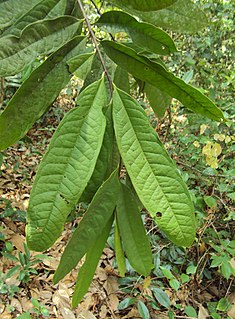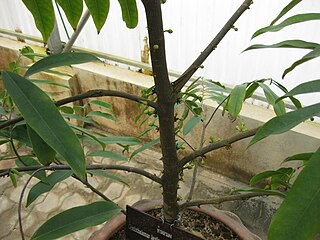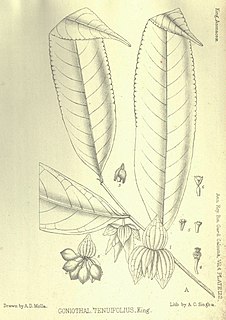
A plum is a fruit of some species in Prunus subg. Prunus. Mature plum fruits may have a dusty-white waxy coating that gives them a glaucous appearance. This is an epicuticular wax coating and is known as "wax bloom". Dried plums are called prunes, which have a dark, wrinkled appearance.

Prunus salicina, commonly called the Japanese plum or Chinese plum, is a small deciduous tree native to China. It is now also grown in fruit orchards in Vietnam, Korea, Japan, the United States, and Australia.

Acacia salicina is a thornless species of Acacia tree native to Australia.

Goniothalamus is one of the largest palaeotropical genera of plant in family Annonaceae.
Goniothalamus cheliensis is a species of plant in the Annonaceae family. It is native to China and Thailand. Bioactive molecules isolated from its roots have been reported to have cytotoxic activity in tests with cultured human cancer cells.

Goniothalamus chinensis is a species of plant in the Annonaceae family. It is found in China and Vietnam.
Goniothalamus gardneri is a species of plant in the Annonaceae family. It is endemic to Sri Lanka.
Goniothalamus majestatis is a species of plant in the Annonaceae family. It is endemic to Sulawesi in Indonesia.
Goniothalamus rhynchantherus is a species of plant in the Annonaceae family. It is native to Kerala and Tamil Nadu in India. It is threatened by habitat loss.
Goniothalamus simonsii is a species of plant in the Annonaceae family. It is endemic to Meghalaya in India.

Goniothalamus wynaadensis is a species of plant in the Annonaceae family. It is endemic to India.

Inula salicina is a plant species in the genus Inula in the family Asteraceae. It is found across Europe and Asia from Portugal to Japan. It has been reported growing in the wild in a few scattered locations in North America but it has not become widely established there.
Baccharis salicina is a species of North American plants in the sunflower family. Common names include willow baccharis, and Great Plains false willow.

Breonadia is a monotypic genus of flowering plants in the family Rubiaceae. It was described by Colin Ernest Ridsdale in 1975. The genus contains only one species, viz. Breonadia salicina, which is found in tropical and southern Africa from Mali and Benin east to Ethiopia, south to South Africa, as well as Yemen, Saudi Arabia and Madagascar.

Melaleuca salicina, commonly known as willow bottlebrush, is a plant in the myrtle family Myrtaceae, and is endemic to eastern Australia. Some Australian state herbaria continue to use the name Callistemon salignus, a name that is accepted by the Australian Plant Census. It is a shrub or small tree with soft foliage, pink new growth, white papery bark and spikes of usually white or creamy bottlebrush flowers in spring.

Goniothalamus giganteus is a species of plant in the family Annonaceae. It is native to Malaya, Myanmar, Sumatra and Thailand. Joseph Dalton Hooker and Thomas Thomson, the British botanists who first formally described the species, named it after its exceptionally large flowers.

Goniothalamus griffithii is a species of plant in the family Annonaceae. It is native to Myanmar and Thailand. Joseph Dalton Hooker and Thomas Thomson the British botanists who first formally described the species, named it in honor of William Griffith, another British botanist who collected the specimen they examined.

Goniothalamus laoticus is a species of plant in the family Annonaceae. It is native to Laos and Thailand. It was originally described by the French botanists Achille Eugène Finet and François Gagnepain using the basionym Mitrephora laotica. In Thailand it is commonly called Khao Lam-dong and is used as a traditional medicine.

Goniothalamus tenuifolius is a species of plant in the family Annonaceae. It is native to Peninsular Malaysia, Thailand and Vietnam. George King, the British botanist who first formally described the species, named it after its slender leaved foliage.













